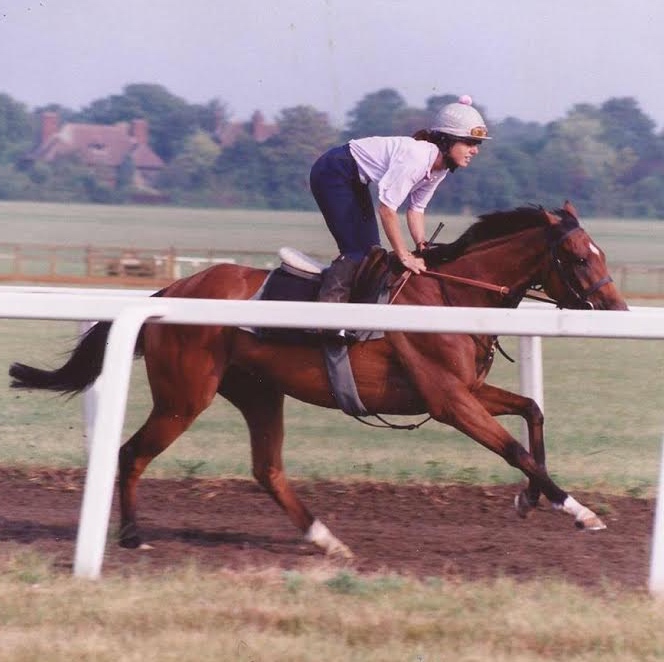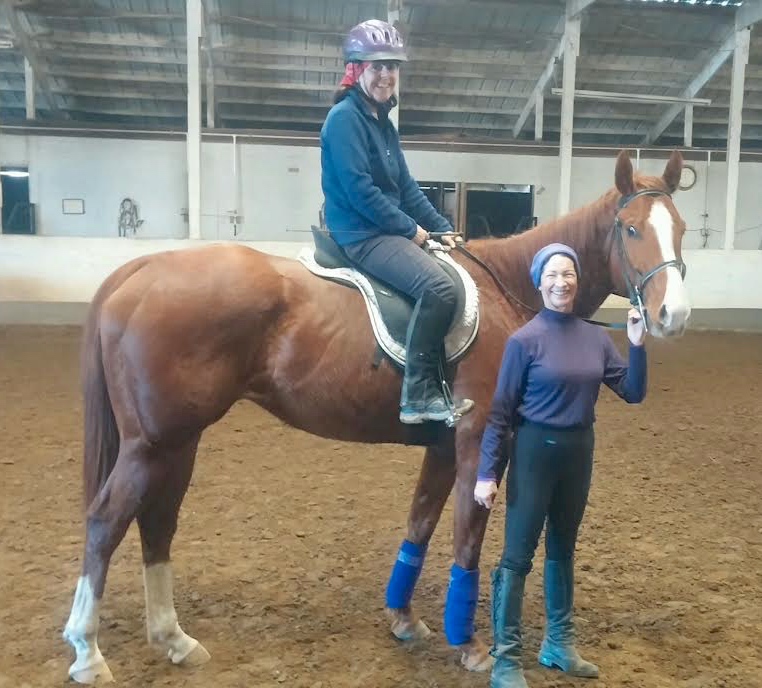
Grace, the very beautiful, very loved OTTB mare rescued from slaughter by equine book author Kim Gatto.
What saved the delicate mare from the slaughterhouse 14 years ago was a combination of little things, really.
First there was Kim Gatto’s ability to see past the Thoroughbred’s nicked, dull coat to envision her at her best; she saw a beauty beneath the shabby exterior of a horse who stood quietly with 30 others at the Pennsylvania auction house. “I could see that she was really pretty underneath,” Gatto recalls. “She was really petite and delicate.”
And the next small thing— the money that would determine who purchased the horse—came down to the price of an inexpensive lunch.
Ten dollars more was what Gatto bid when the mare was led into the auction ring.
“I bid against the meat buyer. He went to $450 and I bid $460,” she says. “I couldn’t believe it. I had tears in my eyes when it was over.”
She had gone to the auction on her riding coach Hilary Cohen’s advice to look for a younger horse for showing, one who would give her childhood mare Chutney some time off.
Race name: Confetti Crossing
New name: Grace
Sire: Festive
Dam: Nearcross
Foal date: March 27, 1995When she caught sight of Grace tethered with 30 other horses, she was a far cry from the beauty she would become. “I had never seen horses in such bad shape,” Gatto says. “Grace was tied in a row of horses and she had no expression; she was thin, and there were cuts all over her.”
And yet, the fine bones of good conformation were evident.
“The horse seller noticed I was looking at her, and got on and trotted her around. She was a really nice mover.”
When Gatto brought her home, the four-year-old was skittish, didn’t trust people, and had never eaten a carrot. Inside of a year, she was winning most of her classes in hunter/ jumper horse shows, eliciting praise from the most discriminating Warmblood owners.
Thinking back, she still can’t believe the slim margins at play on April 20, 1999, the day she went to the New Holland Auction and left with Grace, the Thoroughbred she now calls her “second horse of a lifetime.”
Her first was a Thoroughbred named Chutney. But when the mare died just shy of age 32, Gatto understood that the horse named after Grace Kelly was waiting in the wings.
“Grace was never really affectionate. She was more aloof. But when Chutney died, she suddenly became so affectionate,” Gatto says.
Having just returned from a business trip, she saw Grace in a backfield grazing with the herd. And she called to her. “She looked up and came galloping towards me. She stopped a few feet away and I went up and she let me hug her without moving away.”
That show of affection was one of the most rewarding moments in a story that began the day the Massachusetts equine author decided to take a chance on the ex-racehorse, and has continued to reward her since.
“When we started out, the biggest thing was trying to get her to trust. The first time the farrier came she trembled and reared; we had to get the vet to tranquilize her to do her shoes.”
Gradually, that all changed. By the next year she was winning local dressage shows, including the Charles River Dressage Show.
And Gatto does more than spread the word at local horse shows; she has authored several books and equine magazine articles about Thoroughbreds, and Grace’s story has been featured in horse publications as well.
Her books include Sandsablaze: Grand Prix Greatness from Harrisburg to the Olympics, Beyond the Rainbow Bridge, which deals with horse loss and other forms of separation, and she contributed a chapter to Chicken Soup for the Horse Lover’s Soul on her first Thoroughbred, Chutney.
She has also written Churchill Downs: America’s Most Historic Racetrack, and is completing another volume on Saratoga.
The Franklin, Mass. editor and writer has always been enamored with Thoroughbreds. Each horse has a story and she counts herself fortunate to have known two great characters: Chutney and Grace.
“Chutney has been gone for nearly two years, and I still think of her every day. But my thoughts are no longer on what has been; instead, I look forward to spending each day with Grace.” — Author’s note: This story was originally published in October 2010.








